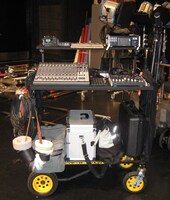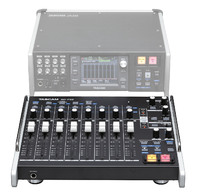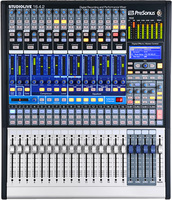 One of the most common questions that comes up is: “What kinds of equipment do you typically bring with you to a shoot? What is on your soundcart?”
One of the most common questions that comes up is: “What kinds of equipment do you typically bring with you to a shoot? What is on your soundcart?”
The answer can vary, of course, depending on several factors, such as the nature of the shoot, the budget, the complexity of the shots, and the preferred or required digital workflow.
But for the sake of providing some sort of baseline for beginners, let’s examine my typical load-out for a low budget, theatrical style, small project.
My soundcart of choice is a Rock N Roller R12RT Multimedia Production Cart. I like the Rock N Roller because it is relatively lightweight and compact for transit, yet opens to a healthy 36” x 24” main shelf, tiered with a 36” x 10” upper hutch. It is equipped with four wide tires so it can negotiate rugged terrain. You can read more about my soundcart elsewhere on this website, so I am not going to go into any lengthy descriptions.
 At the heart of my package is the digital recorder. I personally like the TASACM HS-P82 portable multitrack with timecode that can record two master tracks plus eight additional ISO’s. On most occasions, I pair it up with the TASCAM RC-F82 remote fader controller, which is essentially an eight input mixer.
At the heart of my package is the digital recorder. I personally like the TASACM HS-P82 portable multitrack with timecode that can record two master tracks plus eight additional ISO’s. On most occasions, I pair it up with the TASCAM RC-F82 remote fader controller, which is essentially an eight input mixer.
However, many mixers (sometimes myself included) use the classic Sound Devices 788T paired with its CL-9 remote fader controller; or even the Sound Devices 664 (sometimes with the companion CL-6 that doubles the inputs, so you end up with 12 XLR inputs with up to 4 outputs).
I always bring a USB keyboard to plug into the recorder for speed and convenience.
Adapter cables and proper hook-ups for the recorder and mixer/fader controller are essential. One also needs to have the correct connecting cables to get timecode out of the recorder and into the Denecke slate. Always travel with a complete set of spares!
 Sometimes eight inputs is not enough. For those shoots, I prefer using a Presonus 16.4.2 digital mixing board to feed the 788T or HS-P82.
Sometimes eight inputs is not enough. For those shoots, I prefer using a Presonus 16.4.2 digital mixing board to feed the 788T or HS-P82.
Never go out with just one recorder. What if it breaks?
Your budget will dictate how much of a recorder your backup will be. On major shoots, you would have an identical multi-track with fader controller. On smaller jobs, you will bring whatever you can!
My minor recorder is often either a 744T four-track with timecode, or my TASCAM DR-60 non-timecode four-track. My backup mixer is usually a Mackie 1402 (6x2) or a Behringer 2442 (10x4x2). I also have a simple Sign Video ENG-44 (4x2) over the shoulder mixer for run & gun.
Of course I travel with a few pair of professional headphones. Closed ear, flat response, impedance between 35 ohms to 85 ohms. Favorites include Sony MDR7506 and Audio Technica ATH-M50/M50x, ATH-M40x, ATH-M35, ATH-M30x.
For booming, I like the K-Tek poles very much. You need at least one good pole, not less than 12 foot extended. The KE-144CCR is an excellent choice. It is aluminum for lightweight and strength, internally cabled, and has the XLR output connection on the side — not the bottom!
On my cart, I carry a few poles of varying lengths. A longer pole, for exteriors (and to help counterbalance a long shotgun w zeppelin windscreen). And a shortie, for those tight situations.
A duplex audio cable is essential, so that you can send an audio feed to your boomperson as well as to receive what the shotgun mic is picking up.
As for shotgun mics, you should have at least three different patterns, and only go out with true condensers. My preferences are the Audio Technica BP4073 or the Sennheiser MKH60 short shotgun (medium pattern); the Audio Technica BP4071 or Sennheiser MKH70 (long shotgun); and the Audio Technica AT4051 (aka BP4051 soon) or Sennheiser MKH40 (wider angle to reduce echo during interior shots).
In my kit, I actually carry a couple of each pattern; along with the Audio Technica BP4071L (extra-long shotgun).
Make sure that you have the correct shockmounts and windscreens, of course, for your mics.
Besides the condenser shotgun mics, I always bring a dynamic handheld for grabbing loud sound effects or clean voice-over.
In terms of lavs and wireless, you should have at least two wireless rigs. Actors often wander outside the reach of your boom mic. Or, you may want to record ISO’s of your main characters.
On larger shoots, I like to carry four to six radio mics with me, so that I have enough for scene coverage as well as extra ISO’s.
In my head, I divide my wireless into “tactical” and “defensive” applications. The “tactical” radio mics are the ones that I plan on mixing directly into my “live mix” that will serve as dailies and picture edit. The “defensive” group of wireless is used strictly for back-up ISO’s, in the event that the sound editors need to reconstruct the scene. Of course, the “tactical” radio mics are also recorded as ISO — even though they will be part of my “live mix” as well.
My preferred brand of wireless is Lectrosonics. However, on small shoots, I may use whatever I have access to or personally own, such as Audio Technica, Sennheiser, or Sony. I have discovered that the relatively inexpensive System 10 radio mics from Audio Technica are surprisingly very good and perform excellently in venues that pose high radio frequency interference problems.
The actual lavalier capsule that you mate with your transmitter bodypak is extremely important. Unless you are using junk, most brands of radio mics sound the same, other than a little more or less of residual hiss, which gets lost in the ambiance anyway. What makes or breaks the quality of the sound is your choice of acquisition microphone! I personally like the Audio Technica AT899 or Sennheiser MKE-2 omni capsules for natural sounding pick-up and good matching to the boom. But if you are in a noisy environment, then I switch to the Countryman B3 which still sounds natural yet has very little reach and will keep out background sounds. There are many other good mic choices out there, so you have to experiment and discover your own favorites.
Make sure that at least a couple of your lav capsules come with stand-alone XLR power modules, so that you can use them as hardwired mics rather than wireless. In addition to my lavs that are set up for wireless use, I also bring to the set a couple of hardwired lavs that I can deploy as plant mics. So between the dedicated hardwires, and the power modules — I have multiple lavs at my disposal, should wireless not be an option due to local interference.
Speaking of plant mics, besides the "transparent lavs" such as AT899, MT830R, MKE-2 that I like as plants -- you will also find a barrier plate (aka pressure zone mic) packed in there, as well. I prefer the more directional uniplates rather than an omni pattern.
XLR mic cables are a necessity. On my cart, I usually hang four to six 25 footers, and four 50’s. Stashed away in my cable bag are plenty of short jumpers (1 to 2 foot) and a bunch of 5 foot or 10 footers. Back in my vehicle or camera/sound cage, I have plenty more cables. You can never have too many. I prefer joining multiple fifties together for long runs, rather than 100’s — because the long cables are a real pain to coil properly (and a bigger pain to unravel in a hurry). If you need long cables, I suggest using plastic cable storage reels rather than hand coiling!
Getting power to your equipment is always a concern. Most of the time, all that you need is a long extension power cable and a multi-hole power strip. Pick up some garden type long cords at your local hardware store; you are not powering any big stuff so you do not need motion picture lighting department gauge stingers. Mark the ends of your AC cords with labels to show that they belong to you and not the grip department!
Get a good quality power strip, with surge protection, RFI filtering, and all the stuff you would want for your computer. Some mixers even use computer uninterruptible power back-up supplies.
Most of the time, there will be plenty of AC for you to tap into. If you can use the practical wall sockets, those are generally better than feeds from the set generator. Remind the production company that you are drawing hardly any watts, compared to set lighting.
On those few occasions where there is no AC available, then go battery. Even though the recorder can operate from an internal rechargeable pack, I prefer to keep those for emergency back-up and run the gear from external 12v. Bring or borrow a large capacity camera battery or other “twelve volt” (really a 14v) battery. Your wireless receivers will run for almost a day on their internal batteries, so you are mainly just concerned about your recorder and its companion fader/controller (which draws power from the host recorder).
Leave the big mixing panels behind. If the show is big enough to warrant that many inputs, it is big enough that there will be AC on the set!
A Mackie or Behringer panel can be powered by mean of a computer-grade inverter, that converts 12v DC into usable 117v AC. Make sure that you purchase your inverter from a quality electronics shop, not an auto supply store. It should be rated for computer usage. You do not need a large capacity unit; 150 watts should suffice. But it does need to be “clean” power, which means spending around a hundred bucks or so.
In addition to feeding audio via the duplex cable to your boom operator, you probably will need to provide headphones to the Director, Script Continuity, 2nd Boom, or Client. The standard of the industry is to use a Comtek Assistive Listening System which consists of one wireless (make sure it is battery powered) transmitter, along with at least three belt pack receivers/headphones.
Don’t forget about the little stuff. You should have a small electronic toolkit with soldering iron. Stock a small box with everything needed for rigging lavaliers, such as tapes, safety pins, Moleskin, scissors, alcohol wipes, windscreen materials, colored Sharpies, and so on. Find an old belt (child sizes are best) and put together a tape reel with cloth gaffers tape, cloth camera tapes, white paper tape, clear tape, medical tape, and whatever else you can add.
Fill a large tackle box with as many adapters and audio interconnect cables as you can. You never know what you may have to plug into or out of on a set.
There you have it. Now you know the basic complement of what you need to bring with you.
As I have said, your inventory will vary, depending on the nature of the shoot and your budget.
Those of us who have been doing this for a long time own a lot of gear, and so we will bring a lot more stuff with us. The way I see it, even if I cannot charge the Producer for everything that I bring along — it is for my own benefit to have plenty of contingency equipment at my disposal. In the end, no one cares how much you got paid or reimbursed for gear; all that matters is the quality of the soundtrack that you were able to deliver.
